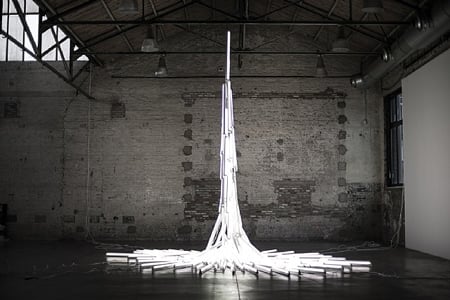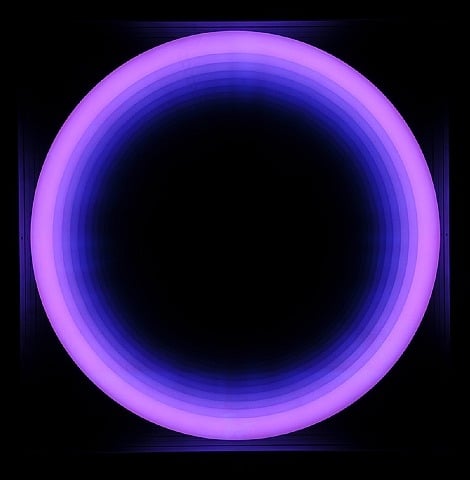Art & Exhibitions
Gallery Hopping on Thursdays: January 30, 2014
This week we are jumping across the pond to check out two exhibitions: one in Paris and one in Brussels.

This week we are jumping across the pond to check out two exhibitions: one in Paris and one in Brussels.

You will have to be a serious Euro traveler to catch all of the exciting exhibitions opening this week.
They were blind, they only saw images will be on view January 30 to March 8 at Yvon Lambert, 108 rue Vieille du Temple, 75003 Paris, France.
First stop is the city of lights. This week, Paris-based gallery Yvon Lambert will host the first solo exhibit for Moroccan artist Mounir Fatmi (Moroccan, b.1970). This exhibition, entitled, They were blind, they only saw images, examines the relationship between vision and religion, and how the two influence one another. Using a variety of artistic media, Fatmi delves ambitiously into this inexhaustible subject.
Of note are a group of pieces called La Divine Illusion, which mix psychological theory with religious texts. In the early 20th century, the Freudian psychoanalyst Herman Rorschach developed the famous inkblot test. The object of this test was to unlock the subconscious motivations of patients under analysis. The structure of the test was simple: a series of abstract images were presented to patients, and, in response, they were asked identify the content of the image. The idea behind this test was to provoke a quick interpretation of an image, and, by extension, provide insight into personal motivations. In this series of images, Fatmi applies the Rorschach test to religion. In the creation of the works, he placed Rorschach images directly on top of religious texts. By combining these two different ways of seeing, Fatmi questions the literalness of religious texts, suggesting that they are open to individual interpretation. The use of Rorschach images oblige the viewer to interpret and think critically about the source of their beliefs. Furthermore, this series explores the possibility that religion and its associated texts are deeply rooted in subjective experiences, and do not communicate one irrefutable message.
Another group of works illustrate Fatmi’s fascination with the controversial writer Salman Rushdie, who is known for writing about the ongoing cultural conflict between the East and West. In a video work inspired by a similar Andy Warhol (American, 1928–1987) piece, the writer is shown fast asleep. Fatmi did not use real footage to create this piece, instead he used video technology to simulate how he imagined the writer would appear while sleeping. This piece is very simple in concept, but it raises questions about what constitutes authority. Depicting a cultural luminary in this way highlights the underlying paradoxes surrounding the concept of idolatry. Regardless of how highly esteemed someone might be, the fact that they are human and consequently subject to normal biological processes cannot be erased. Like all the works in this show, these pieces unpack the connection between what we hold as sacred and the nature of truth.

Chul Hyun Ahn, Visual Echoes, Portal, 2013, plywood, mirror, fluorescent lights, and color gels, Galerie Paris-Beijing, Brussels, Belgium
Korean Shape will be on view January 30 to March 29 at Galerie Paris-Beijing, Hôtel Winssinger, rue de l’Hôtel des Monnaies 66, 1060 Brussels, Belgium.
Our next European destination is Brussels, Belgium. This Thursday, East meets West in a new way at Galerie Paris-Beijing. In an effort to shine a spotlight on an art community that is often overlooked, Galerie Paris-Beijing, has curated a special show called Korean Shape, which will be offering a selection of works from a group of emerging Korean artists. Considered to be long overdue, this show is designed to expand cultural awareness of Asian artwork outside of traditionally popular regions such as Japan and China. The works chosen for this show combine traditional artistic practices with modern techniques. In effect, Korean Shape offers a survey of artistic practices that reference tradition while simultaneously illustrating the fact that Modernism has cross-cultural implications and is not confined exclusively to the West.
Browse openings by city to see where art can be found in your town!
Munich, Germany
Picasso: Zeichnungen, Graphik und Keramik at Galerie Thomas
January 30–March 29, 2014
Maximilianstraße 25, 80539 Munich, Germany
New York, NY
Fred W. McDarrah: Save the Village at Steven Kasher Gallery
January 30–March 8, 2014
521 W. 23rd Street, New York, NY
Michael Gregory: Northwest Passage at Nancy Hoffman Gallery
January 30–March 8, 2014
520 W. 27th Street, New York, NY
San Franciso, CA
30 x 30: A 30th Anniversary Exhibition and Celebration at Caldwell Snyder Gallery
January 30–February 28, 2014
341 Sutter Street, San Francisco, CA